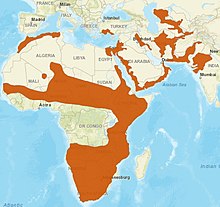
Back Rooikat Afrikaans ዳልጋ ኣንበሳ Amharic Caracal caracal AN عناق الأرض Arabic عناق الارض ARZ Caracal caracal AST Mutcol (Caracal caracal) AVK Adi qaraqulaq Azerbaijani کرکل AZB Каракал Byelorussian
| Caracal | |
|---|---|

| |
| Caracal in Kgalagadi Transfrontier Park | |
| Scientific classification | |
| Domain: | Eukaryota |
| Kingdom: | Animalia |
| Phylum: | Chordata |
| Class: | Mammalia |
| Order: | Carnivora |
| Suborder: | Feliformia |
| Family: | Felidae |
| Subfamily: | Felinae |
| Genus: | Caracal |
| Species: | C. caracal
|
| Binomial name | |
| Caracal caracal (Schreber, 1776)
| |
| Subspecies | |
|
See text | |

| |
| Distribution of caracal, 2016[1] | |
| Synonyms | |
|
List
| |
The caracal (Caracal caracal) (/ˈkærəkæl/) is a medium-sized wild cat native to Africa, the Middle East, Central Asia, and arid areas of Pakistan and northwestern India. It is characterised by a robust build, long legs, a short face, long tufted ears, relatively short tail, and long canine teeth. Its coat is uniformly reddish tan or sandy, while the ventral parts are lighter with small reddish markings. It reaches 40–50 cm (16–20 in) at the shoulder and weighs 8–19 kg (18–42 lb). It was first scientifically described by German naturalist Johann Christian Daniel von Schreber in 1776. Three subspecies are recognised.
Typically nocturnal, the caracal is highly secretive and difficult to observe. It is territorial, and lives mainly alone or in pairs. The caracal is a carnivore that typically preys upon birds, rodents, and other small mammals. It can leap higher than 3.0 m (10 ft) and catch birds in midair. It stalks its prey until it is within 5 m (16 ft) of it, after which it runs it down and kills it with a bite to the throat or to the back of the neck. Both sexes become sexually mature by the time they are one year old and breed throughout the year. Gestation lasts between two and three months, resulting in a litter of one to six kittens. Juveniles leave their mothers at the age of nine to ten months, though a few females stay back with their mothers. The average lifespan of captive caracals is nearly 16 years.
- ^ a b c Avgan, B.; Henschel, P. & Ghoddousi, A. (2016) [errata version of 2016 assessment]. "Caracal caracal". IUCN Red List of Threatened Species. 2016: e.T3847A102424310. doi:10.2305/IUCN.UK.2016-2.RLTS.T3847A50650230.en. Retrieved 15 January 2022.
- ^ Cite error: The named reference
MSW3was invoked but never defined (see the help page).
Cite error: There are <ref group=note> tags on this page, but the references will not show without a {{reflist|group=note}} template (see the help page).
